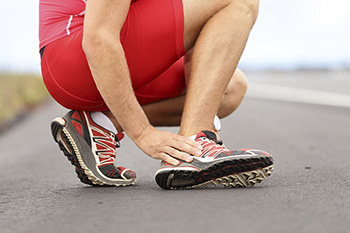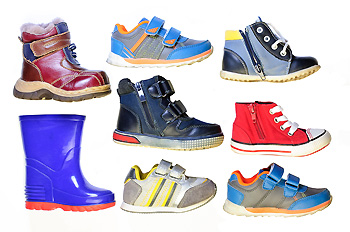
A stress fracture of the foot can be painful, and it may cause challenges in completing daily activities. It is also known as a hairline fracture, and will gradually worsen if not treated promptly. This type of break is defined as a tiny crack in any of the foot bones, or it may occur in the lower leg. It is a common injury among people who enjoy participating in running and jumping activities, and the bones may gradually become weaker from repetitive use. Additionally, it may happen as a result of increasing speed or mileage too quickly while running. Patients who have nutritional imbalances or who have had previous stress fractures may be prone to having them occur again. This type of fracture is generally treated by resting the affected foot and temporarily stopping the activity that caused this condition. Research has indicated that a complete recovery generally takes approximately eight weeks, and may be accelerated by performing low impact exercises like swimming or cycling. If you have endured a stress fracture, please consider speaking with a podiatrist who can help you with the treatment plan that is correct for you.
Stress fractures occur when there is a tiny crack within a bone. To learn more, contact one of our podiatrists from McKinney Podiatric Associates, PA. Our doctors can provide the care you need to keep you pain free and on your feet.
How Are They Caused?
Stress fractures are the result of repetitive force being placed on the bone. Since the lower leg and feet often carry most of the body’s weight, stress fractures are likely to occur in these areas. If you rush into a new exercise, you are more likely to develop a stress fracture since you are starting too much, too soon. Pain resulting from stress fractures may go unnoticed at first, however it may start to worsen over time.
Risk Factors
Stress fractures do not always heal properly, so it is important that you seek help from a podiatrist if you suspect you may have one. Ignoring your stress fracture may cause it to worsen, and you may develop chronic pain as well as additional fractures.
If you have any questions, please feel free to contact one of our offices located in Pasadena, Baytown, League City, Houston, and Pearland,TX . We offer the newest diagnostic and treatment technologies for all your foot care needs.

Toddlers are usually flat-footed when they start to walk, and their feet may turn inward known as in-toeing. Flat feet should resolve as bones develop and the feet become stronger. In-toeing should also improve with age. Toddlers should go barefoot or wear soft-soled shoes to promote balance, posture, and coordination. Children receive important sensory information from the soles of their feet touching the ground and they develop muscle strength this way. When children have been walking confidently for some time, they can begin to wear firmer-soled shoes. Footwear can help protect their feet from injury and temperature. Their feet should be professionally measured for length and width. Kids' feet grow quickly, and their shoe size may change every few months. Shoes that are too tight can negatively affect a child’s walking pattern and cause other problems like ingrown toenails. Instead, children’s shoes should be comfortable, with plenty of room in the toe box. They should have a flexible, flat sole that can bend near the toe. The front of the shoe should be wider than the heel, to match the foot's natural shape. The shoes need to be secured with laces or straps that prevent the foot from moving or slipping. See a podiatrist if your child is experiencing foot pain or if you are concerned with how they walk.
The health of a child’s feet is vital to their overall well-being. If you have any questions regarding foot health, contact one of our podiatrists of McKinney Podiatric Associates, PA. Our doctors can provide the care you need to keep you pain-free and on your feet.
Tips for Keeping Children's Feet Healthy
If you have any questions, please feel free to contact one of our offices located in Pasadena, Baytown, League City, Houston, and Pearland,TX . We offer the newest diagnostic and treatment technologies for all your foot care needs.

People who have endured an Achilles tendon injury are often not mistaken about it. A common sign is an immediate pain and discomfort, and it can be extremely difficult to walk. It can happen as a result of increasing running speed and mileage too quickly, and this type of injury can fall into two categories. Noninsertional Achilles tendinitis affects the middle of the tendon, and younger people are prone to developing this type of injury. The lower part of the tendon is affected where it attaches to the heel bone during insertional Achilles tendinitis and can affect people of all ages. Additional symptoms can include heel and calf pain, and there can be a limited range of motion. Some people develop Achilles tendon injuries from not warming up or cooling down properly, in addition to wearing shoes that do not fit properly. This is an injury that needs prompt medical attention for a complete recovery so it is suggested that a podiatrist be contacted who can guide you toward the best treatment techniques.
Achilles tendon injuries need immediate attention to avoid future complications. If you have any concerns, contact one of our podiatrists of McKinney Podiatric Associates, PA. Our doctors can provide the care you need to keep you pain-free and on your feet.
What Is the Achilles Tendon?
The Achilles tendon is a tendon that connects the lower leg muscles and calf to the heel of the foot. It is the strongest tendon in the human body and is essential for making movement possible. Because this tendon is such an integral part of the body, any injuries to it can create immense difficulties and should immediately be presented to a doctor.
What Are the Symptoms of an Achilles Tendon Injury?
There are various types of injuries that can affect the Achilles tendon. The two most common injuries are Achilles tendinitis and ruptures of the tendon.
Achilles Tendinitis Symptoms
Rupture Symptoms
Treatment and Prevention
Achilles tendon injuries are diagnosed by a thorough physical evaluation, which can include an MRI. Treatment involves rest, physical therapy, and in some cases, surgery. However, various preventative measures can be taken to avoid these injuries, such as:
If you have any questions please feel free to contact one of our offices located in Pasadena, Baytown, League City, Houston, and Pearland,TX . We offer the newest diagnostic tools and technology to treat your foot and ankle needs.

Tinea pedis, more commonly known as athlete’s foot, is considered to be a fungal skin infection. It is generally found between the toes or on the soles of the feet. The fungus enters the body through small cracks in the skin and may develop into a chronic infection. This type of fungus lives in warm and moist environments and is contagious. Some of the places where appropriate shoes are urged to be worn are public swimming pools, shower room floors, and locker rooms. There are methods that can be implemented to help prevent the spread of athlete's foot. These include keeping the toenails trimmed and airing shoes out while alternating them every other day. It is beneficial to wear shoes and socks that are made of breathable materials, which helps to keep the feet clean and dry. Athlete’s foot generally does not heal on its own, and a podiatrist is often consulted who can provide an accurate diagnosis and offer correct treatment options.
Athlete’s Foot
Athlete’s foot is often an uncomfortable condition to experience. Thankfully, podiatrists specialize in treating athlete’s foot and offer the best treatment options. If you have any questions about athlete’s foot, consult with one of our podiatrists from McKinney Podiatric Associates, PA. Our doctors will assess your condition and provide you with quality treatment.
What Is Athlete’s Foot?
Tinea pedis, more commonly known as athlete’s foot, is a non-serious and common fungal infection of the foot. Athlete’s foot is contagious and can be contracted by touching someone who has it or infected surfaces. The most common places contaminated by it are public showers, locker rooms, and swimming pools. Once contracted, it grows on feet that are left inside moist, dark, and warm shoes and socks.
Prevention
The most effective ways to prevent athlete’s foot include:
Symptoms
Athlete’s foot initially occurs as a rash between the toes. However, if left undiagnosed, it can spread to the sides and bottom of the feet, toenails, and if touched by hand, the hands themselves. Symptoms include:
Diagnosis and Treatment
Diagnosis is quick and easy. Skin samples will be taken and either viewed under a microscope or sent to a lab for testing. Sometimes, a podiatrist can diagnose it based on simply looking at it. Once confirmed, treatment options include oral and topical antifungal medications.
If you have any questions, please feel free to contact one of our offices located in Pasadena, Baytown, League City, Houston, and Pearland,TX . We offer the newest diagnostic and treatment technologies for all your foot care needs.